
Electrification could cost-efficiently bust the vast majority of greenhouse gases arising from North Sea platforms.
According to the winners of a competition designed to speed up the decarbonisation of oil and gas installations, alternative power sources have the potential to reduce emissions by up to 87%.
Industry regulator the North Sea Transition Authority (NSTA) has today published the full reports of the three victors of the platform electrification contest.
Launched in September and backed by £1 million from UK Government as part of the North Sea Transition Deal (NSTD), the competition aims to bring innovative solutions for electrifying assets by supporting oil and gas companies, wind developers and technology suppliers.
According to the NSTA, all three winning studies – lodged by Orcadian Energy and partners, Orsted (CPH: ORSTED) and Neptune Energy, and Katoni Engineering – cover the “building blocks” of any offshore electrification scheme.
They demonstrate concepts that don’t need power from shore, instead creating renewable power systems, opening up as much as 4 gigawatts (GW) of offshore wind across the UK North Sea.
Each solution can be “easily complemented” by power cables from onshore, and suggest emmissions reduction of between 78% and 87% are achievable.
They also highlight the importance of robust, yet cost-effective power distribution systems offshore.
These facilities, or micro-grids, integrate different power sources with multiple offshore users.
Scott Robertson, NSTA director of operations, said: “Platform electrification is a vital part of cutting emissions in the North Sea and reaching net zero.
“Each of these projects contains useful, innovative thinking and we expect industry to look at these ideas, and others, as electrification projects start to become reality in the next few years.”
Within the NSTD, the oil and gas industry has committed to reduce offshore emissions by 50% in 2030, a 2-3 MtCO2 per year reduction.
To achieve these goals, the NSTA is working with industry representatives to progress prospective electrification projects, including those in the central North Sea and West of Shetland.
Orcadian Energy and partners (Crondall, Enertechnos, NSMP, Petrofac and Wartsila)
The Orcadian-led study has designed standardised off-grid floating power distribution hubs, which receive renewable power from floating offshore windfarms and combine that power with low-emission back-up power generation.
Each power distribution hub is placed close to the receiving installations to minimise the length of the power distribution cables.
The solution is phased and scalable, and applicable across multiple regions of the UKCS.
Under certain circumstances, ‘all-in’ project costs can be up to 26% lower than comparable power from shore electrification.
Orsted, Neptune Energy and Goal 7 - Project Neos
This pre-Front End Engineering Design (pre-FEED) study investigated the technical and commercial aspects of an electrical connection between an offshore wind farm and an offshore oil and gas installation without connection from shore.
Two technical concepts were investigated, using subsea cables and considering concept feasibility in terms of power availability and reliability. P
Project Neos further considered the design modifications which would be required at the O&G installation and evidenced the need to create an offshore microgrid, including back up generation, energy storage and advanced control to stabilise the switch from renewable power to back-up power generation.
The study has demonstrated the levels of technical feasibility and which drivers can make projects more cost effective, such as maximum CAPEX related to infrastructure upgrades, and minimum remaining field life. Sensitivities to gas, electricity and carbon prices were also investigated.
Katoni Engineering
The Katoni study has designed an optimised offshore electricity distribution network which minimises the cost of brownfield platform modifications by delivering power at, or as close to, current platform power voltages as possible.
This network design results in a circa 75% reduction of modification costs vs earlier assumptions.
The network includes back-up power generation located on a centralised floating electrical distribution hub to ensure power continuity in this off-grid electrical network design. The power distribution network was designed using a power clustering methodology may include electrification of circa 20 platforms within a significant portion of the Central North Sea area.
Recommended for you

